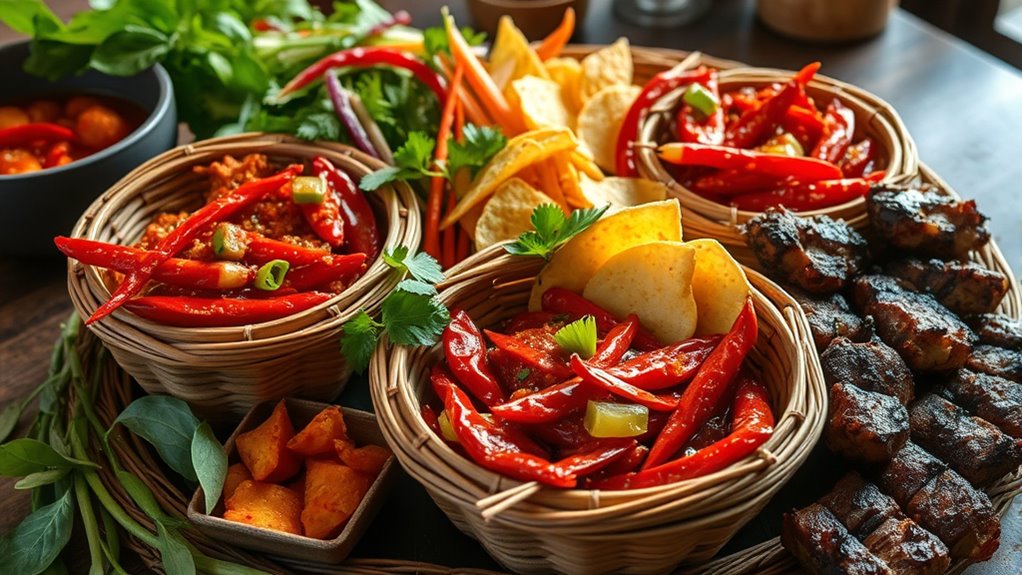The Northeast’s cuisine combines Native American ingredients like corn, shellfish, and cranberries with colonial influences such as baked beans and hearty stews. You’ll find signature dishes like clam chowder, lobster rolls, and seafood bakes reflecting the region’s rich fishing traditions. Local ingredients, festivals, and sustainable practices shape its vibrant food scene. If you want to explore the diverse flavors, traditions, and modern innovations that make this cuisine unique, there’s more to discover.
Key Takeaways
- Northeastern cuisine blends Native American ingredients like corn, shellfish, and game with colonial and French influences.
- Signature dishes include clam chowder, lobster rolls, baked beans, and tourtière, highlighting seafood and hearty preparations.
- Key ingredients such as cranberries, fiddleheads, pumpkin, and maple syrup define regional flavors.
- Food festivals celebrate seafood, harvests, and indigenous culinary traditions, fostering community and cultural preservation.
- Modern innovations focus on sustainable sourcing, farm-to-table practices, and revitalizing indigenous ingredients through contemporary techniques.
The Roots of Northeastern Cuisine: Native American and Colonial Influences
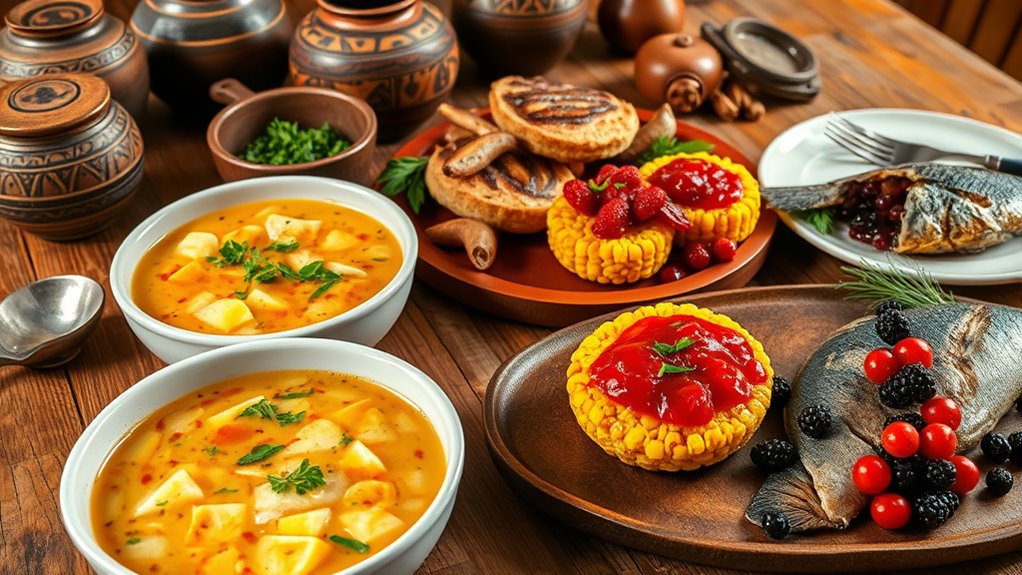
The roots of Northeastern cuisine are deeply shaped by both Native American traditions and colonial influences. You’ll notice how Native Americans introduced essential ingredients like corn, shellfish, cranberries, and game meats, which early settlers quickly adopted. These ingredients became staples, especially in dishes like clam chowder and baked beans. On the colonial side, English settlers brought cooking methods and ingredients such as maple syrup and salt pork, which became integral to regional recipes. The region’s abundant seafood, including lobster and clams, also plays a crucial role. Over time, these diverse influences blended, creating a rich culinary heritage. This history highlights a community that values its indigenous ingredients and colonial traditions, laying the foundation for the Northeast’s unique and enduring food culture. Additionally, the development of regional food traditions reflects how local resources and cultural exchanges continue to shape Northeast cuisine today.
Signature Dishes and Regional Specialties of the Northeast
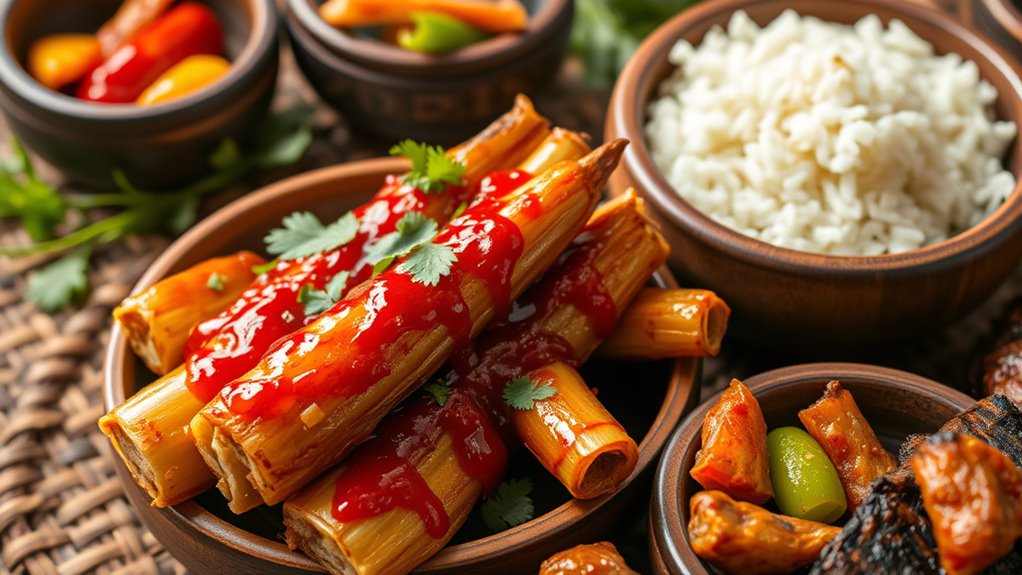
Across the Northeast, signature dishes and regional specialties vividly showcase the area’s culinary diversity and rich heritage. You’ll find iconic foods like Boston baked beans, clam chowder, and lobster rolls that reflect local ingredients and traditions. Imagine steaming clambakes outdoors or savoring cranberry sauces during fall. Here’s a glimpse of regional specialties:
| Dish | Main Ingredients | Regional Focus |
|---|---|---|
| Boston Baked Beans | Navy beans, molasses | New England Tradition |
| Clam Chowder | Clams, potatoes, cream | Coastal Seafood |
| Lobster Roll | Lobster, bun, mayo | Maine and Massachusetts |
| Tourtière | Meat pie, spices | Northern Maine |
These dishes evoke the region’s seafood bounty, Native influences, and colonial roots. Culinary heritage plays a vital role in shaping these regional flavors and cooking techniques.
Key Ingredients That Define the Region’s Flavors
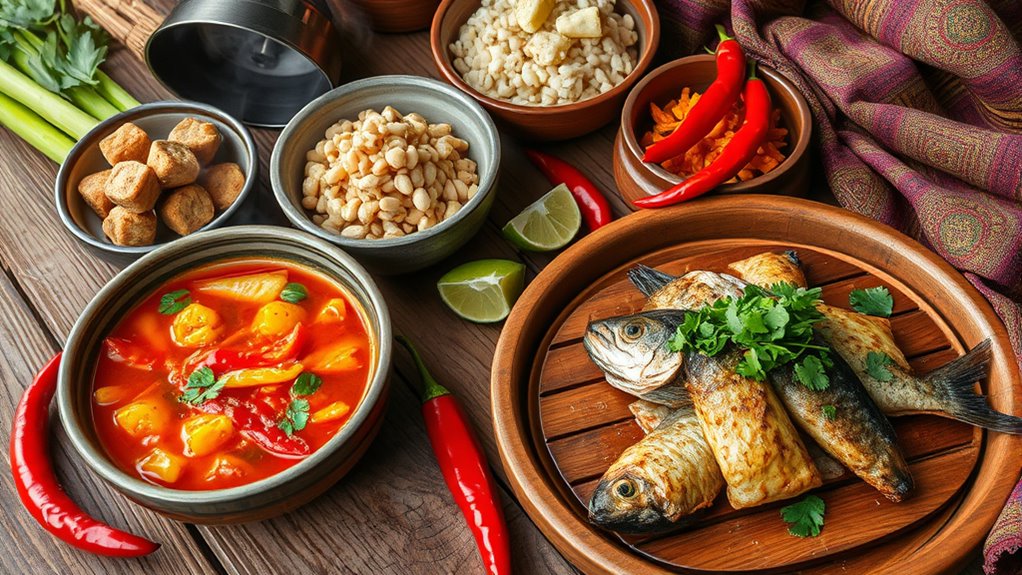
Native ingredients have shaped the distinctive flavors of Northeast cuisine, reflecting the region’s rich natural resources and agricultural bounty. You’ll find that maple syrup is a sweetening staple, used in everything from desserts to savory dishes, highlighting the abundant forests. Cranberries, harvested from bogs, add tartness to sauces, relishes, and baked goods, showcasing the region’s bountiful harvest. Fiddleheads, foraged in the wild, bring a fresh, grassy flavor to seasonal dishes like succotash. Seafood plays a central role, with clams, lobster, and fish forming the backbone of many recipes, thanks to the Atlantic’s plentiful waters. Additionally, pumpkins and squash are essential ingredients in autumn fare, while game meats like venison reflect hunting traditions. These ingredients define the region’s vibrant, hearty flavors that continue to influence its culinary identity. Sustainable harvesting practices also support the preservation of these natural resources, ensuring their availability for future generations.
Cultural Contributions Shaping the Culinary Landscape
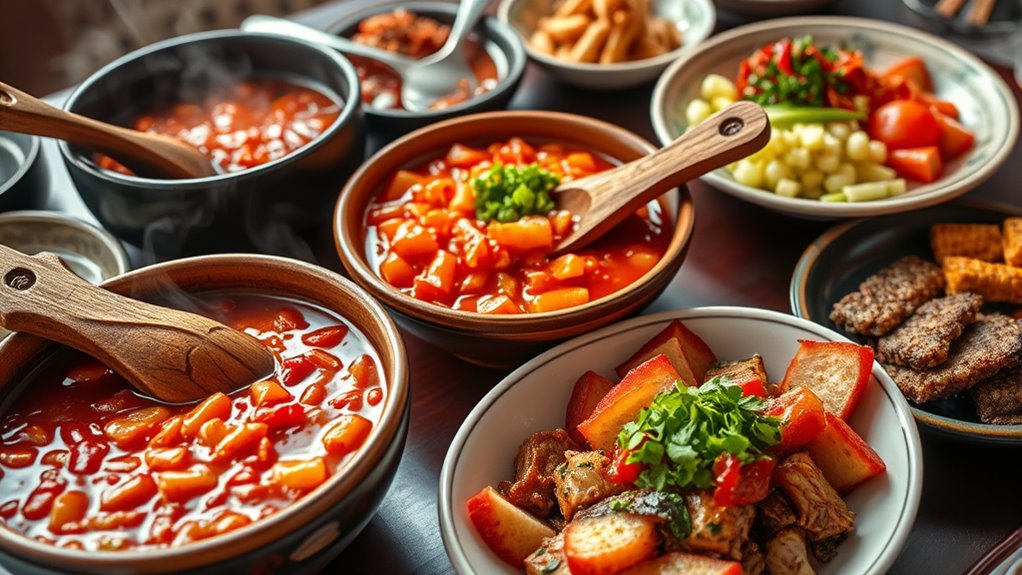
Cultural contributions play a vital role in shaping the culinary landscape of the Northeast, blending diverse traditions into a rich tapestry of flavors. Native American practices introduced ingredients like corn, game, and shellfish, which still influence regional dishes today. Colonial heritage brought English methods, evident in baked beans and hearty stews. French and Acadian influences appear in dishes like tourtière and crepes, reflecting the region’s French-speaking communities. You’ll find that seafood traditions, such as clam bakes and lobster boils, are rooted in the region’s abundant coastal resources. Community events, like seafood festivals and harvest celebrations, reinforce cultural ties through shared food experiences. These varied influences create a culinary identity that honors history while fostering ongoing innovation and regional pride. Understanding culinary history helps appreciate the depth of regional flavors and techniques that continue to evolve today.
Innovations and Modern Food Movements in the Northeast
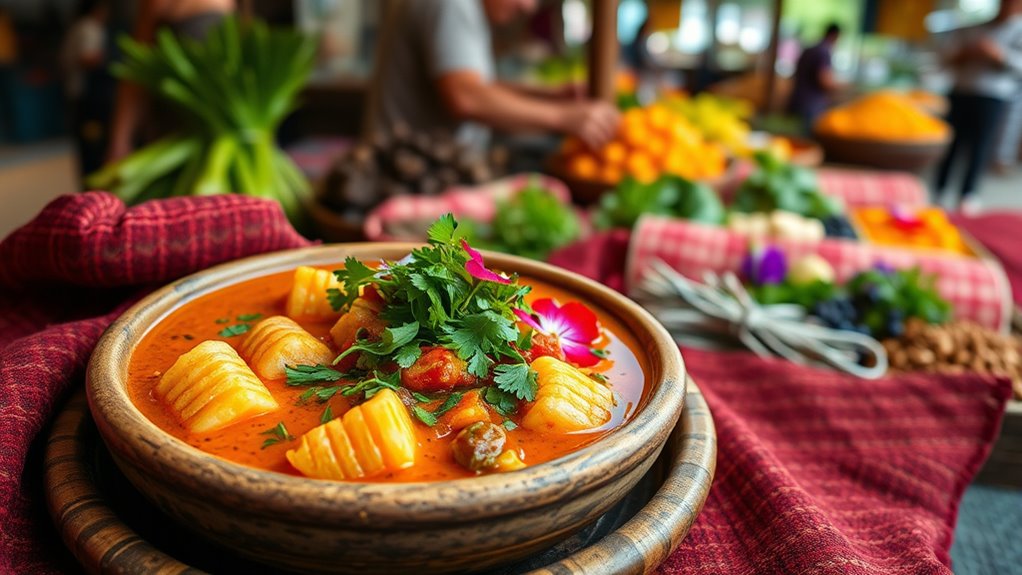
Modern food movements in the Northeast are transforming traditional cuisine through innovative techniques and a strong emphasis on sustainability. You’ll find chefs experimenting with farm-to-table concepts, sourcing ingredients locally to support regional farmers and reduce environmental impact. Urban culinary scenes, especially in cities like Portland and Boston, showcase diverse, progressive menus that blend historical flavors with modern twists. Many restaurants focus on sustainable seafood, ensuring long-term preservation of marine resources. You’ll also notice a resurgence of Indigenous ingredients and recipes, revitalized through contemporary approaches. Culinary innovation here isn’t just about new dishes—it’s about redefining food systems, promoting eco-friendly practices, and celebrating local heritage. Smart indoor gardens and other innovative growing technologies are increasingly being integrated into local food production, encouraging sustainable and year-round ingredient sourcing. This movement encourages creativity while honoring the region’s rich culinary history, making Northeast cuisine both innovative and rooted in tradition.
Celebratory Food Events and Market Traditions
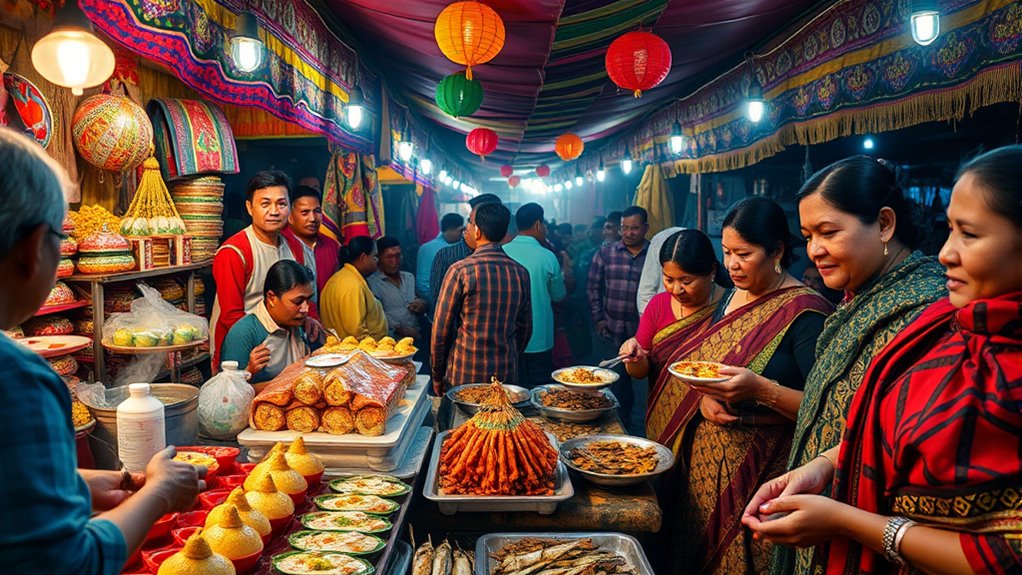
You’ll find that seasonal food festivals and local market celebrations are central to the Northeast’s culinary culture. These events bring communities together to enjoy fresh, regional ingredients and traditional dishes. They also showcase the region’s rich harvests and food heritage in lively, memorable gatherings. Incorporating local ingredient sourcing strategies, many of these festivals emphasize sustainable and locally focused food practices.
Seasonal Food Festivals
Seasonal food festivals in the Northeast celebrate the region’s rich agricultural and seafood traditions, drawing communities together to enjoy locally sourced dishes. These festivals highlight harvests and regional specialties, creating vibrant gatherings that showcase fresh ingredients. You’ll find events centered around apple picking, pumpkin patches, and cranberry harvests, where local farmers and seafood providers share their bounty. Typically, these festivals feature cooking demonstrations, tastings, and cultural performances, emphasizing community participation. The table below illustrates some common festivals:
| Festival Type | Key Features |
|---|---|
| Autumn Harvest Festivals | Apples, pumpkins, fall produce |
| Seafood Festivals | Clam bakes, lobster boils |
| Indigenous Food Events | Native ingredients, traditions |
Additionally, these celebrations often serve as opportunities to learn about regional culinary heritage, fostering appreciation for traditional cooking methods and indigenous ingredients.
Local Market Celebrations
Throughout the year, local market celebrations and food events bring Northeast communities together to showcase regional flavors and support local producers. You’ll find bustling farmers markets, where vendors sell fresh produce like pumpkins, cranberries, and fiddleheads, highlighting the region’s seasonal bounty. Seafood festivals and clambakes celebrate the area’s fishing heritage, often featuring live cooking demonstrations and tasting booths. Autumn harvest festivals spotlight apples, squash, and homemade baked goods, creating vibrant social gatherings. Indigenous food events educate visitors about Native American culinary traditions, emphasizing ingredients like wild game and foraged herbs. These celebrations foster community spirit, encourage sustainable practices, and preserve regional foodways. Participating in market events gives you a firsthand experience of the Northeast’s rich culinary heritage and vibrant local scene. Incorporating advanced segmentation techniques into event promotion can help target specific audiences and increase engagement.
Embracing Sustainability and Indigenous Food Revival
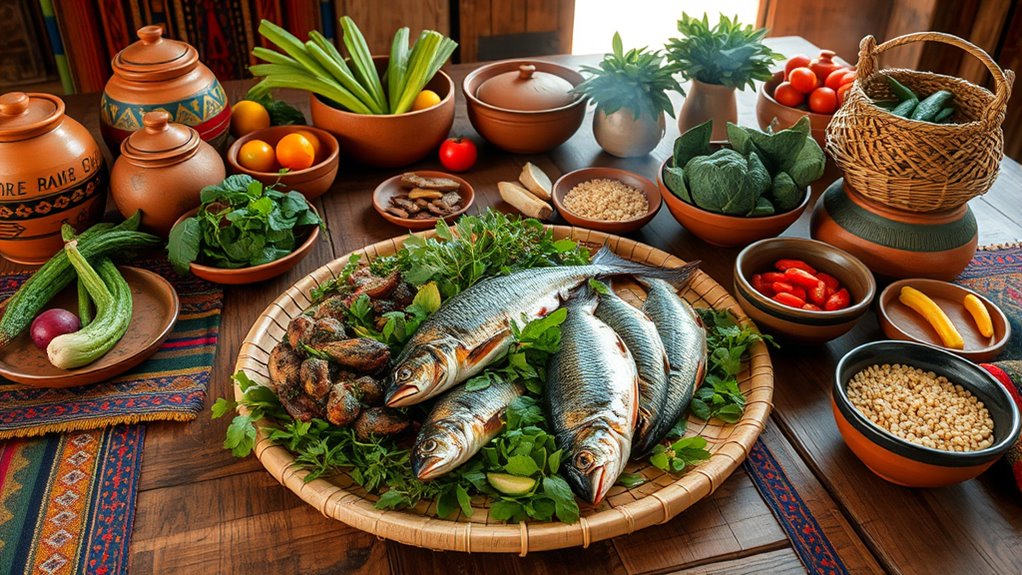
You can see a growing focus on reviving native ingredients and practicing sustainable seafood harvesting in the Northeast. Chefs and communities are prioritizing local, traditional foods to safeguard the environment and cultural heritage. This movement helps ensure these culinary traditions thrive for future generations. Additionally, many are adopting dynamic communication exercises to foster collaboration and shared understanding among local stakeholders involved in this revival.
Native Ingredients Revival
The Native Ingredients Revival is gaining momentum as chefs and communities prioritize sustainable practices and honor Indigenous culinary traditions. You’ll find a renewed focus on ingredients like wild fiddleheads, cranberries, and game meats, which connect the region’s food to its heritage and environment. This movement emphasizes sourcing locally and respecting ecological balance. To showcase this, consider the following native ingredients:
| Ingredient | Usage |
|---|---|
| Fiddleheads | Sautéed or added to salads |
| Cranberries | Sauces, relishes, baked goods |
| Pumpkin & Squash | Soups, pies, roasted dishes |
| Game Meats | Stews, roasts, traditional dishes |
Sustainable Seafood Practices
As communities embrace Indigenous food traditions and prioritize sustainable practices, seafood consumption in the Northeast has shifted toward more responsible methods. You can now find efforts to protect fish populations through regulated harvesting and catch limits that prevent overfishing. Many restaurants and markets focus on sourcing from local, sustainable fisheries, ensuring seafood is caught responsibly. Indigenous communities actively participate in reviving traditional harvesting techniques that respect marine ecosystems, like shellfish aquaculture and selective fishing. These practices help maintain biodiversity and ensure future generations can enjoy local seafood. Public awareness campaigns and policies promote sustainable seafood choices, encouraging you to opt for eco-friendly options. By supporting these initiatives, you contribute to the region’s ecological health while celebrating the rich culinary heritage embedded in Northeastern seafood. Building resilience and empathy around sustainable practices fosters a collective commitment to preserving marine resources for the long term.
Frequently Asked Questions
How Did Puritan Sabbath Rules Influence Northeastern Food Traditions?
You notice that Puritan Sabbath rules shaped northeastern food traditions by encouraging early settlers to prepare meals in advance. They often cooked dishes like baked beans on Saturdays, so they wouldn’t violate Sabbath restrictions on cooking. This practice made baked beans a Saturday staple, influencing the region’s culinary rhythm. You can see how religious observances directly affected meal schedules and traditional dishes, creating lasting culinary habits.
What Role Does Foraging Play in Contemporary Northeastern Cuisine?
You might be surprised, but foraging remains a essential part of contemporary Northeastern cuisine. As you explore local markets or hike through forests, you’ll find chefs and home cooks gathering fiddleheads, wild berries, and ramps, adding fresh, seasonal flavors to dishes. This natural connection emphasizes sustainability and tradition, blending old Native American practices with modern culinary innovation to create unique, locally sourced meals that celebrate the region’s rich natural bounty.
How Are Indigenous Culinary Practices Being Preserved Today?
You can see indigenous culinary practices being preserved today through community-led workshops, festivals, and educational programs that highlight Native ingredients and cooking methods. Many chefs incorporate traditional foods like fiddleheads, cranberries, and game meats into their menus, respecting these traditions. Additionally, efforts to restore native food systems and promote Indigenous-led initiatives help sustain and celebrate these culinary practices for future generations.
What Are the Most Popular Seafood Dishes Across the Northeast?
You’ll find clam chowder, lobster rolls, and clambakes as the shining stars of Northeast seafood, each telling a story of the ocean’s bounty. Imagine steaming lobsters pulled straight from the sea, their claws bursting with flavor, or creamy chowder warming your hands on a chilly day. These dishes are more than food—they’re the heartbeat of coastal communities, celebrating the region’s rich maritime heritage in every delicious bite.
How Has Farm-To-Table Movement Transformed Regional Dining?
The farm-to-table movement has transformed regional dining by making locally sourced ingredients central to menus. You now see chefs emphasizing sustainability, freshness, and supporting local farmers, which enhances flavor and quality. This shift encourages you to enjoy seasonal dishes that reflect the region’s harvests, fostering a deeper connection to the local food culture. It also promotes eco-friendly practices, ensuring that the Northeast’s culinary scene remains vibrant and responsible.
Conclusion
As you explore the rich flavors and traditions of the Northeast, you’ll uncover stories that go beyond the plate. From historic influences to modern innovations, this region’s culinary scene is constantly evolving. But what’s next for its food culture? Will sustainability and indigenous revival shape a new chapter? Keep tasting, learning, and watching — because the future of Northeastern cuisine might just surprise you in ways you never expected.

